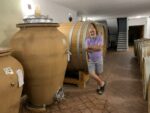Nadalié Cooperage
This week I decided to show you the “behind the scenes” of a barrel cellar …. the cooperage.
Few people think “A barrel is just a barrel. All are same” Big mistake!
The manufacture of a Bordeaux barrel is a subtle art that requires the marriage of flavors, skills, the respect of a land and the passion … the same way as the assembly of a wine from Bordeaux.
So, I went to meet one of the largest Gironde cooperages: the TONNELLERIE NADALIE.
“A family history of 5 generations, and specifically since 1902” … this could be the title of this article
Unlike others – like Bordeaux or Burgundy- this company is not just a cooperage but a forester. This allows a monitoring, a traceability, an incomparable quality …. from the planting to the barrel, and through slaughter.
 Where does the logo of Nadalié come from? The emblem of this company is a Barge, a famous ship from Gironde used for wine transportation from the properties to the banks of Chartrons, heart of the wine trade of the Port of Bordeaux.
Where does the logo of Nadalié come from? The emblem of this company is a Barge, a famous ship from Gironde used for wine transportation from the properties to the banks of Chartrons, heart of the wine trade of the Port of Bordeaux.
Philosophy: passion, respect for the land, skills, perfectionism …. here are the crux words of this company.
Why Mr. Nadalié, from his place in Gironde, decided to settle in Ludon Medoc? Simply, to enjoy the influence of the ocean, and a moisture content that ensures the exceptional ideal of wood during the phase of leaching / drying.
This company, besides its headquarters located in the Medoc, has locations in Charente, in Allier, in Australia, California and Chile.
All right, now let´s retrace all the design of a barrel:
First, it is essential to note that 80% of the oaks used are from French forest Tronçais like, Never, Allier, or Central France. The finest specimens suitable for use in the manufacture of barrels, are from the Tronçais. It is thanks to Colbert, who decided in 1670, the management of the forest, that at that time was in a very bad condition. Then, plantations and oak seedlings will be made for timber production of marine, that was indispensable to the formation of a royal navy worthy of that name. (The cultural moment: Hermione, was a famous frigate chartered by the Marquis de Lafayette in 1779 to cross the Atlantic to support the American War of Independence against the British, and was built through this policy of planting).
Back on topic. French oak, that because of its typicality, and fine-grained tannins can be more flexible, thinner. The exchanges between wood and wine are interesting. This type of grain also helps obtaining wine for aging.
1 – Selection
A strict selection of oak in plots rely auctioned by the ONF is performed in order to know the potential. Each tree is examined in terms of its foliage, wood, its circumference, its curvature, and the regularity of its bark.
Note that only the trunk of the tree will be used in the manufacture of staves. Knowing that the wood is split along the wire, 5 m3 timber represents the final stave of 1m3. The rest will be transformed into alternative or sold to manufacturers in the timber industry …. the branches will be sold as firewood
2 – Cup
Slaughtered under the supervision of the ONF, standby moon descending sap, the oaks are immediately taken to the sawmill / the stave (Nadalié possesses some in France) to be processed by the wood stave “mérandier” (it rattles the wood planks into smaller boards)
Carefully stacked, like a Lego, on the grounds of the cooperage. The staves are watered and left to the elements (sun, rain, wind) for over two years to release the tannins of the hardest woods, the bitterness, the remaining sap but also so that the wood can, by then express the richest aroma possible.,
4 – Identification of staves
 The staves, remained grouped in batches, are laid on a flat barrel pattern to determine the order of placement, mark the drill hole plug (what you see “corked” on the barrel)and to verify that each stave is perfect for both the cut, the quality of wood (knots and wood grain) and the level of aesthetics (spotless).
The staves, remained grouped in batches, are laid on a flat barrel pattern to determine the order of placement, mark the drill hole plug (what you see “corked” on the barrel)and to verify that each stave is perfect for both the cut, the quality of wood (knots and wood grain) and the level of aesthetics (spotless).
It should be noted, that by customer’s request it is possible to assemble several types of wood for the same barrel.
After coring operations (within the staves are planed), to skiving (process of giving curvature to the final shape to the stave) and jointing, the staves become moats (“plate” of wood perfectly cut and curved, ready for assembly of the barrel) are selected one by one by the master cooper.
Alongside this, the bottom piece will be assembled through the use of cane in order to ensure tightness.
6 – Setting Pink
Assembly of circular moat which was the forerunner. The rose is the result of painstaking work, at every stage of manufacture. The assembly is done through steel cables that will force the timber to make the desired curvature.
7 – Heater
A heating tailored to each particular client request is made, through the action of fire, water, and especially of the hand of man. At the end of this stage, the barrel takes its final form but is “open” on each side.
It is during this stage that the various species of wood, different flavors are given / disclosed.
There are several types of heat: mild, moderate and strong. Depending on the wood heater will reveal very different flavors (nutty, cocoa, coffee … etc.). The heat affects the length and persistence of wines too.
8 – Assembly
Putting the Pieces of funds from the barrel joined with the spots is 100% natural, for sealing. And closure of the barrel.
9 – “Echauffage”
Fill the barrel with 30 gallons of boiling water, complemented by its air pressure. This is made to test the tightness of the barrel and wash.
10 – Sanding
Is done by machine requiring the passage of the barrel twice because it does a pumice side at a time.
11 – Marking
 Laser marking the name of the heater used (example: hazelnut), the lot number from the wood, allowing traceability to the oak barrels. Finally the stamp of the logo Nadalié.
Laser marking the name of the heater used (example: hazelnut), the lot number from the wood, allowing traceability to the oak barrels. Finally the stamp of the logo Nadalié.
History does not let a week pass without an anecdote is this: contrary to what is commonly thought, it is possible to make barrels with other woods than oak (bringing other different flavors) as chestnut, cherry , acacia wood … If these are not widely used, it is mainly due to a supply problem.
Quick Tip of the Week gourmet (With the agreement of the owners) go to the collection of “mache” (type of salad) in the feet of the vines!
Thanks to the Nadalié company for hosting us.
Jonathan Choukroun Chicheportiche
Nadalié 99 rue Lafont à Ludon-Medoc
33295 Blanquefort









